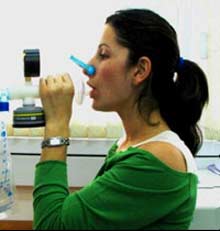Cancer-Sniffing E-Nose Can Differentiate Between Various Forms of the Disease
Scientists working on a breath test for cancer say they can differentiate between at least four different forms of the...


Breast Cancer Cells
Scientists working on a breath test for cancer say they can differentiate between at least four different forms of the disease, regardless of the patient’s age, gender or lifestyle, simply by testing patients’ breath.
Previous research by the same team found gold nanoparticle sensors could distinguish between the breath of healthy patients and those with lung cancer. Now, the e-nose can tell if a patient has breast, lung, prostate or colon cancer, according to the researchers, from the Technion Israel Institute of Technology in Haifa.
The e-nose detects volatile organic compounds measured in just a few parts per billion. The VOCs, which are emitted from the surface of cells, are a result of gene and protein changes that occur because of tumor growth, according to the study, published today in the British Journal of Cancer.
The sensor could provide an early warning system that unveils cancer even before tumors become visible in X-rays, as AFP reports.
The researchers tested the exhaled breath of 177 volunteers ranging in age from 20–75, including patients with lung, colon, breast, and prostate cancers and healthy patients who acted as controls. Breath from the cancer patients was collected before any treatment.
The sensor, which involves an array of gold nanoparticles and a gas chromatograph, could detect differences in the patients’ breath patterns, according to the study. Its statistical analysis was valid regardless of variables like patient age, gender or lifestyle.
Abraham Kuten, who co-authored the study, tells AFP that if confirmed in larger-scale studies, the technique could become a simple, portable and non-invasive tool for diagnosing cancer.
It could also be an easy way to monitor cancer treatment and watch for relapses, he says.